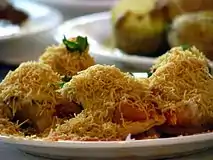Sev (food)
Sev is a popular Indian snack food[1] consisting of small pieces of crunchy noodles made from chickpea flour paste, which are seasoned with turmeric, cayenne, and ajwain[2] before being deep-fried in oil.[3][4][5] These noodles vary in thickness.[6] Ready-to-eat varieties of sev, including flavoured sev, are available in Indian stores.[7]
 Sev | |
| Course | Snack |
|---|---|
| Place of origin | India |
| Region or state | North India |
| Main ingredients | Chickpea flour |
| Variations | Potato sev |
Sev is eaten as a standalone snack as well as a topping on dishes like bhelpuri and sevpuri. Sev can be made at home and stored for weeks in airtight containers.[7]
Sev is a popular snack in most part of northern India particualrly Uttar Pradesh and Bihar where it is eaten alongwith sweetened Boondi topped over it. The snack is also popular in Madhya Pradesh, especially in the cities of Indore, Ujjain and Ratlam, where many snack foods consist of sev as a main ingredient. In Madhya Pradesh, sev is used as a side ingredient in almost every chaat snack food, especially ratlami sev, which is made from cloves and chickpea flour. Many varieties of sev are sold commercially, such as long (clove) sev, tomato sev, palak sev, plain sev, and bhujia.
In the UK, popular varieties of sev mixed with nuts, lentils and pulses are commonly sold as 'Bombay mix'.
 Yellow bits of sev on sevpuri
Yellow bits of sev on sevpuri
References
- Raina, Usha (2001). Basic Food Preparation (Third Edition). Orient Blackswan. p. 290. ISBN 8125023003.
- "Crispy Sev Recipe for a Crackling Diwali".
- Gress, Priti Chitnis (2008). Flavorful India: Treasured Recipes from a Gujarati Family. Hippocrene Books. p. 35. ISBN 0-7818-1207-0.
- Brennan, Jennifer (1984). The cuisines of Asia: nine great oriental cuisines by technique. St. Martin's/Marek. pp. 26. ISBN 0-312-66116-9.
- King, Niloufer Ichaporia (2007). My Bombay kitchen: traditional and modern Parsi home cooking. University of California Press. p. 311. ISBN 0-520-24960-7.
- Aruna Thaker, Arlene Barton (2012). Multicultural Handbook of Food, Nutrition and Dietetics. John Wiley & Sons. p. 17. ISBN 1-4051-7358-0.
- Doshi, Malvi (2002). Cooking Along the Ganges: The Vegetarian Heritage of India. iUniverse. p. 174. ISBN 0-595-24422-X.